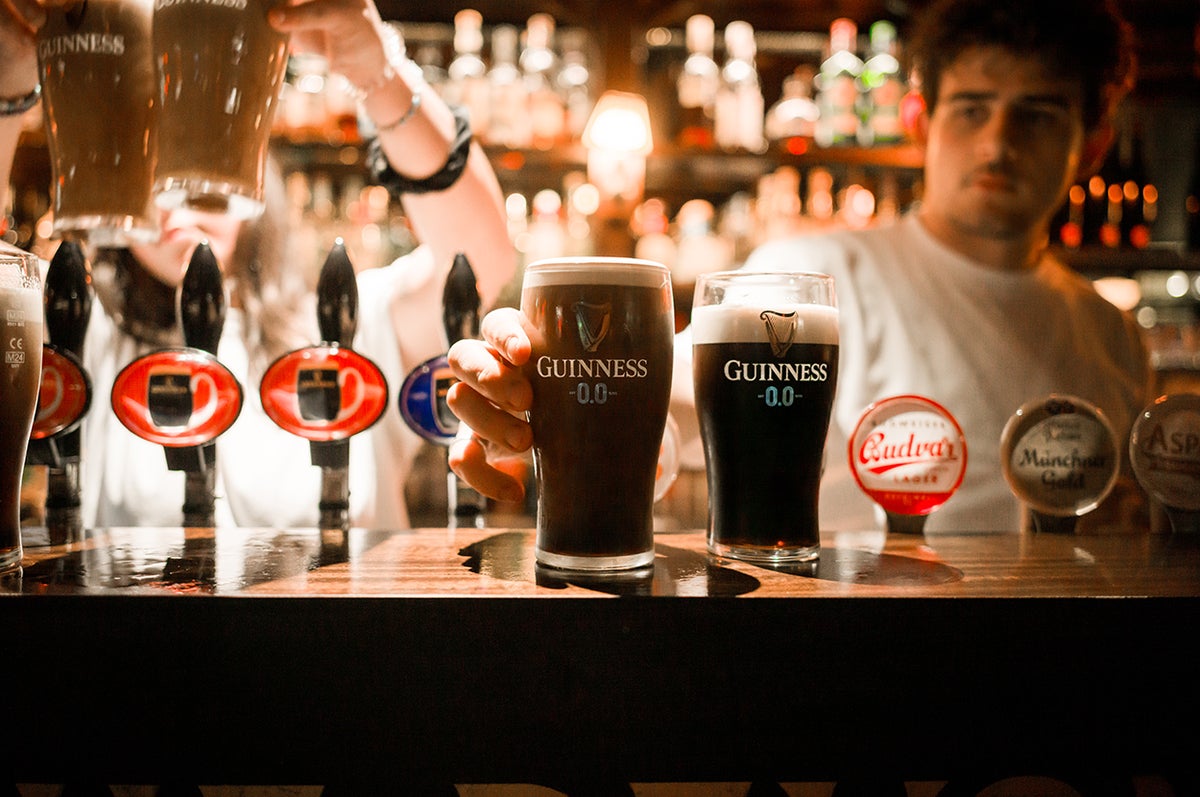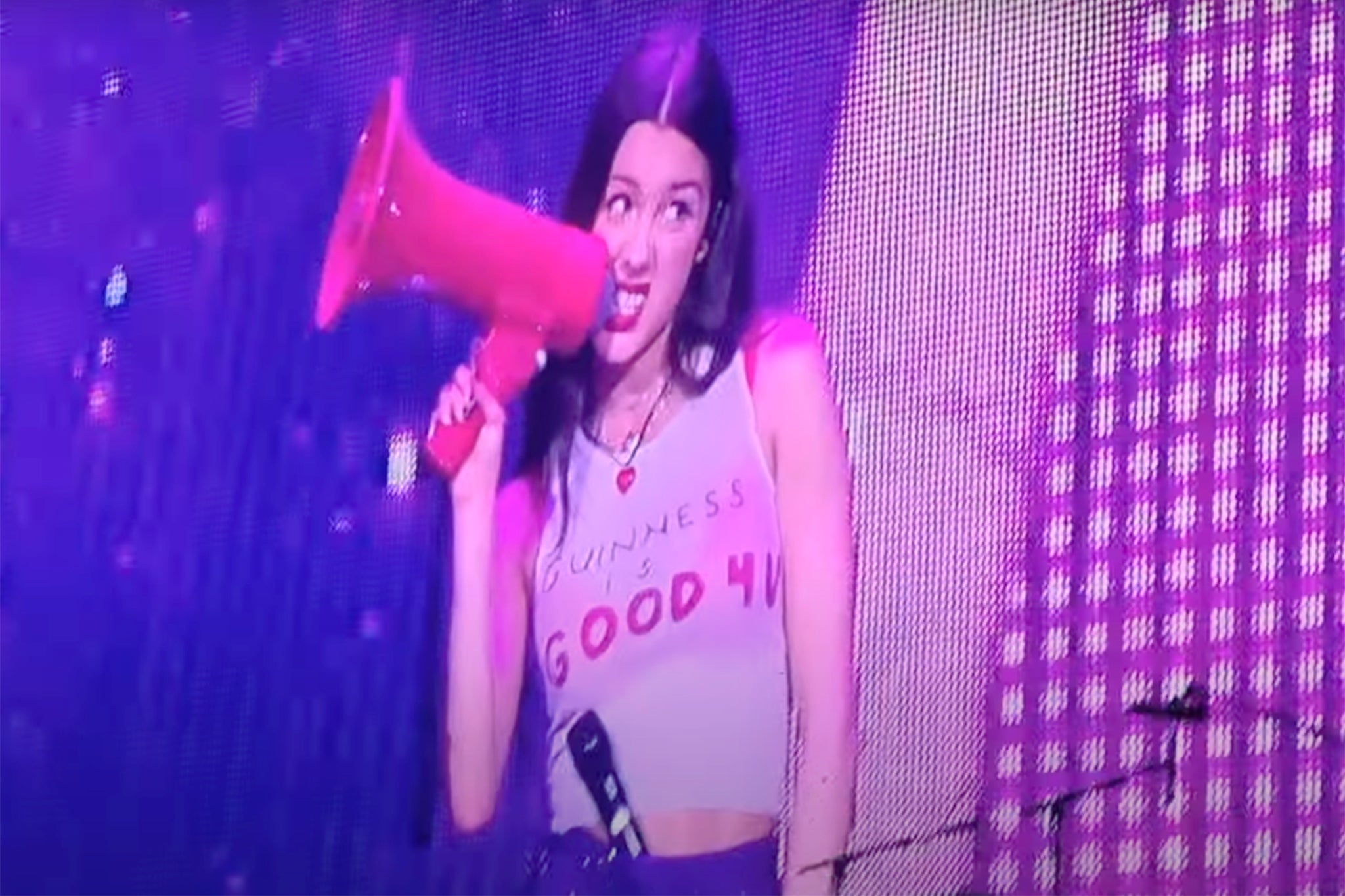
Your support helps us to tell the story
Our mission is to deliver unbiased, fact-based reporting that holds power to account and exposes the truth.
Whether $5 or $50, every contribution counts.
Support us to deliver journalism without an agenda.

Louise Thomas
Editor
At first glance, there’s nothing out of the ordinary about a pint of Guinness 0.0. The velvet black pour, the creamy foam head balancing delicately on the rim of the glass, the familiar satisfaction of watching it settle. But there’s one crucial ingredient missing: the alcohol.
Guinness 0.0 has been gaining serious momentum. Recently, Diageo, its parent company, reported an 18 per cent growth in beer sales over the fiscal year, driven largely by increased demand for Guinness, with 0.0 sales doubling year on year. Until recently, this alcohol-free version of the iconic stout was only available in cans, but now it’s pouring from taps outside of Ireland for the first time right here in London at The Devonshire pub in Soho... for £6.35 a pint, just 55p less than regular Guinness. That sound you just heard? It’s the collective gasp of the Irish diaspora.
Guinness 0.0 isn’t some half-hearted nod to temperance or a substitute for the “real thing”. It’s the product of a much larger cultural movement, the rise of “NoLo” (no- and low-alcohol) drinks, continuing to sweep the UK and Ireland. No longer are non-alcoholic drinks the sole property of some lonely teetotaller lingering in the corner. Today’s modern drinker is a different breed – one that prioritises wellness without sacrificing taste and experience. They want to have their pint and drink it too. The real revelation? That someone would pay full price for the privilege.
And yet, at The Devonshire, “not a single customer has mentioned the price since we started serving it”, says landlord Oisín Rogers. Over 500 pints of Guinness 0.0 are poured at the Soho pub each week, which is no small feat for a product still finding its feet in the NoLo space. More surprising still is the fact that the Great British public, famously vocal about the price of everything from milk to Freddo bars, hasn’t batted an eyelid at shelling out £6.35 for a pint with no booze.
This isn’t Guinness’s first foray into the NoLo market. Back in the 1980s, the drinks giant dipped its toe into the sobriety pool with Kaliber, a non-alcoholic beer so uninspiring it failed to make even a ripple in the heavy-drinking waters of the time. It tried again in the early 2000s with Guinness Mid-Strength, a 2.8 per cent ABV stout for those who wanted the taste but not the hangover (regular Guinness is 4.2 per cent). But that wasn’t quite the cultural moment they hoped for, either.
Fast forward to the age of sober curiosity and things look very different. Millennials and Gen-Zers are leading a cultural revolution – one that values mindfulness, health and moderation over boozed-up regret. Studies show that a quarter of young adults in the UK are now teetotal, and the NoLo movement has seen alcohol-free options in the UK grow by 24 per cent over the past year alone. They’re not giving up on the pub entirely but they’re redefining what it means to enjoy a pint.
Enter Guinness 0.0: a beer that gives you everything – the flavour, the texture, the ritual of the pour – without the booze. “When consumers choose Guinness Draught 0.0, they expect the iconic two-part pour, a gorgeous creamy head, and the perfect temperature, in a clean Guinness branded glass,” says Steve Gilsenan, master brewer and head of quality at Guinness. “They want the same keg experience that has become synonymous with Guinness Draught, and so they should.” By all accounts, they’ve succeeded. “It’s almost unbelievable that it’s alcohol-free at all,” says Rogers. And that’s exactly the point.

The brewing process mirrors that of regular Guinness, from the malt to the hops, the barley to the yeast. But producing an alcohol-free beer that delivers the same rich, creamy mouthfeel and roasted malt flavour as Guinness is not easy. Some non-alcoholic beers rely on heat to evaporate the alcohol, but that risks damaging the delicate flavour compounds. Instead, Guinness has invested in a cold-filtration process, which preserves that distinct roasted bitterness and silky texture.
It hasn’t all been smooth sailing. Shortly after its 2020 launch, Guinness 0.0 hit a speed bump when a contamination issue led to a recall, highlighting that removing alcohol is no easy task. Alcohol is nature’s preservative; it keeps bacteria at bay and gives beer longevity. Its absence means riskier business. With the problem solved, Guinness 0.0 returned a year later, serendipitously timing its comeback with the NoLo boom. And boom it did. In the UK alone, the market grew by 19 per cent in 2022 and is projected to keep growing at 9 per cent annually.
But let’s address the elephant in the room: the price. “It seems to me that the debate about the price has not been fuelled by customers,” says Rogers. “I mean, people pay six quid for a bloody coffee these days, which should really be 50p.” He’s right. In a world where people fork out over a fiver for a run-of-the-mill cappuccino, why shouldn’t a carefully crafted, non-alcoholic Guinness be north of six quid?
Innovation comes at a price. That cold-filtration process, which so perfectly mimics the taste of an alcoholic Guinness, isn’t cheap. Add to that the fact that the pub lines carrying Guinness 0.0 need to be cleaned more frequently (once a week instead of once a fortnight) because, unlike regular Guinness, it doesn’t have the alcohol to inhibit bacterial growth, and the costs start to add up.
The fact is, 0.0 was never intended to be a budget brew – it’s a premium product, sitting comfortably alongside Heineken 0.0 and BrewDog Punk AF. “Our brewing team is hugely proud of the care and effort that has been put into the four-year development process for Guinness 0.0,” says Aisling Ryan, innovation brewer at St James’s Gate, where Guinness has been brewed since 1759. “We’ve created a taste experience that we believe is truly unrivalled in the world of non-alcoholic beer.” It’s made with the same attention to detail as the original, with just as much flavour, if not more. Personally, I’ve seen punters unable to tell the difference between 0.0 and the alcoholic version.

There are plenty of zero per cent beer options on the market – many of them surprisingly decent – so why has Guinness 0.0 emerged as the non-alcoholic beer of the moment? Especially given the stout’s traditionally stuffy image. Once upon a time, it was the preserve of old men, propped up at the bar of creaky, wood-panelled pubs, nursing their pints like they were family heirlooms. It wasn’t the drink of choice for anyone with plans for the evening, let alone young people out to impress. And that whole obsession with “splitting the G” – where your first sip lines up with the logo on the glass? That level of Instagram-friendly precision wasn’t even a twinkle in the publican’s eye.
Then came the #GuinnessChallenge last year, a viral sensation that took over Instagram and TikTok. Suddenly Guinness was cool. Videos of perfectly poured pints, including Guinness 0.0, filled the feeds of younger drinkers, turning the soupy stout into something aspirational. Suddenly, it wasn’t about the booze but about the ritual, the pour and, of course, whether you could chug an unfathomable amount in one go.
Celebrity endorsements have helped bolster its standing, too. Last year, Tom Hanks caused a stir with his unholy mix of Guinness and Diet Coke, while Liam Neeson has long embodied the ruggish Irishman with a pint of the black stuff. Add in younger stars like Kim Kardashian and Olivia Rodrigo and you’ve got a product that’s appealing to everyone from Hollywood A-listers to TikTok teens.
Clearly, the trend isn’t slowing down. “We’re seeing both new customers and people who alternate between Guinness 0.0 and regular Guinness, particularly at lunchtime,” says Rogers. “People like to have a couple of pints, and it really looks like they’re enjoying themselves.” In other words, Guinness 0.0 isn’t just for the sober crowd. It’s part of a more flexible drinking experience, where consumers can choose, or moderate, depending on the occasion.
Ultimately, the rise of Guinness 0.0 tells us this: drinking culture is evolving. Consumers aren’t just looking to get plastered – they’re seeking out flavour, experience and, dare I say it, balance. It’s no longer a binary choice between getting boozed up or abstaining entirely. Why shouldn’t a premium product like Guinness 0.0, meticulously designed to replicate the taste, texture, and ritual of the original, be priced around the same as its alcoholic sibling? At £6-plus, that’s a bargain.







